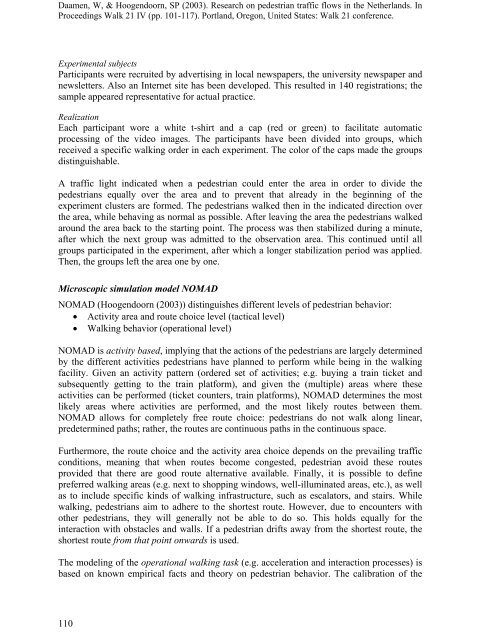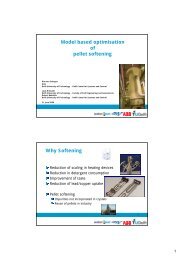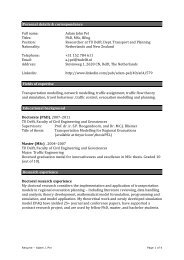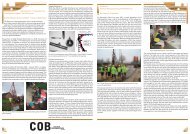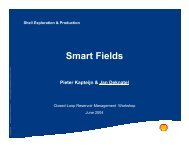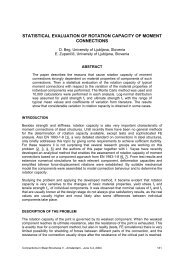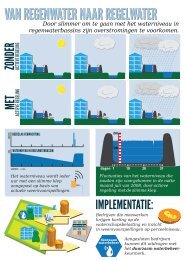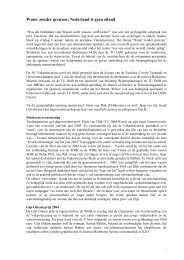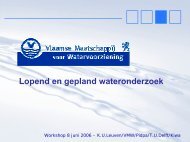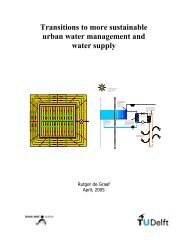Research on pedestrian traffic flow in the Netherlands - TU Delft
Research on pedestrian traffic flow in the Netherlands - TU Delft
Research on pedestrian traffic flow in the Netherlands - TU Delft
Create successful ePaper yourself
Turn your PDF publications into a flip-book with our unique Google optimized e-Paper software.
Daamen, W, & Hoogendoorn, SP (2003). <str<strong>on</strong>g>Research</str<strong>on</strong>g> <strong>on</strong> <strong>pedestrian</strong> <strong>traffic</strong> <strong>flow</strong>s <strong>in</strong> <strong>the</strong> Ne<strong>the</strong>rlands. In<br />
Proceed<strong>in</strong>gs Walk 21 IV (pp. 101-117). Portland, Oreg<strong>on</strong>, United States: Walk 21 c<strong>on</strong>ference.<br />
Experimental subjects<br />
Participants were recruited by advertis<strong>in</strong>g <strong>in</strong> local newspapers, <strong>the</strong> university newspaper and<br />
newsletters. Also an Internet site has been developed. This resulted <strong>in</strong> 140 registrati<strong>on</strong>s; <strong>the</strong><br />
sample appeared representative for actual practice.<br />
Realizati<strong>on</strong><br />
Each participant wore a white t-shirt and a cap (red or green) to facilitate automatic<br />
process<strong>in</strong>g of <strong>the</strong> video images. The participants have been divided <strong>in</strong>to groups, which<br />
received a specific walk<strong>in</strong>g order <strong>in</strong> each experiment. The color of <strong>the</strong> caps made <strong>the</strong> groups<br />
dist<strong>in</strong>guishable.<br />
A <strong>traffic</strong> light <strong>in</strong>dicated when a <strong>pedestrian</strong> could enter <strong>the</strong> area <strong>in</strong> order to divide <strong>the</strong><br />
<strong>pedestrian</strong>s equally over <strong>the</strong> area and to prevent that already <strong>in</strong> <strong>the</strong> beg<strong>in</strong>n<strong>in</strong>g of <strong>the</strong><br />
experiment clusters are formed. The <strong>pedestrian</strong>s walked <strong>the</strong>n <strong>in</strong> <strong>the</strong> <strong>in</strong>dicated directi<strong>on</strong> over<br />
<strong>the</strong> area, while behav<strong>in</strong>g as normal as possible. After leav<strong>in</strong>g <strong>the</strong> area <strong>the</strong> <strong>pedestrian</strong>s walked<br />
around <strong>the</strong> area back to <strong>the</strong> start<strong>in</strong>g po<strong>in</strong>t. The process was <strong>the</strong>n stabilized dur<strong>in</strong>g a m<strong>in</strong>ute,<br />
after which <strong>the</strong> next group was admitted to <strong>the</strong> observati<strong>on</strong> area. This c<strong>on</strong>t<strong>in</strong>ued until all<br />
groups participated <strong>in</strong> <strong>the</strong> experiment, after which a l<strong>on</strong>ger stabilizati<strong>on</strong> period was applied.<br />
Then, <strong>the</strong> groups left <strong>the</strong> area <strong>on</strong>e by <strong>on</strong>e.<br />
Microscopic simulati<strong>on</strong> model NOMAD<br />
NOMAD (Hoogendoorn (2003)) dist<strong>in</strong>guishes different levels of <strong>pedestrian</strong> behavior:<br />
• Activity area and route choice level (tactical level)<br />
• Walk<strong>in</strong>g behavior (operati<strong>on</strong>al level)<br />
NOMAD is activity based, imply<strong>in</strong>g that <strong>the</strong> acti<strong>on</strong>s of <strong>the</strong> <strong>pedestrian</strong>s are largely determ<strong>in</strong>ed<br />
by <strong>the</strong> different activities <strong>pedestrian</strong>s have planned to perform while be<strong>in</strong>g <strong>in</strong> <strong>the</strong> walk<strong>in</strong>g<br />
facility. Given an activity pattern (ordered set of activities; e.g. buy<strong>in</strong>g a tra<strong>in</strong> ticket and<br />
subsequently gett<strong>in</strong>g to <strong>the</strong> tra<strong>in</strong> platform), and given <strong>the</strong> (multiple) areas where <strong>the</strong>se<br />
activities can be performed (ticket counters, tra<strong>in</strong> platforms), NOMAD determ<strong>in</strong>es <strong>the</strong> most<br />
likely areas where activities are performed, and <strong>the</strong> most likely routes between <strong>the</strong>m.<br />
NOMAD allows for completely free route choice: <strong>pedestrian</strong>s do not walk al<strong>on</strong>g l<strong>in</strong>ear,<br />
predeterm<strong>in</strong>ed paths; ra<strong>the</strong>r, <strong>the</strong> routes are c<strong>on</strong>t<strong>in</strong>uous paths <strong>in</strong> <strong>the</strong> c<strong>on</strong>t<strong>in</strong>uous space.<br />
Fur<strong>the</strong>rmore, <strong>the</strong> route choice and <strong>the</strong> activity area choice depends <strong>on</strong> <strong>the</strong> prevail<strong>in</strong>g <strong>traffic</strong><br />
c<strong>on</strong>diti<strong>on</strong>s, mean<strong>in</strong>g that when routes become c<strong>on</strong>gested, <strong>pedestrian</strong> avoid <strong>the</strong>se routes<br />
provided that <strong>the</strong>re are good route alternative available. F<strong>in</strong>ally, it is possible to def<strong>in</strong>e<br />
preferred walk<strong>in</strong>g areas (e.g. next to shopp<strong>in</strong>g w<strong>in</strong>dows, well-illum<strong>in</strong>ated areas, etc.), as well<br />
as to <strong>in</strong>clude specific k<strong>in</strong>ds of walk<strong>in</strong>g <strong>in</strong>frastructure, such as escalators, and stairs. While<br />
walk<strong>in</strong>g, <strong>pedestrian</strong>s aim to adhere to <strong>the</strong> shortest route. However, due to encounters with<br />
o<strong>the</strong>r <strong>pedestrian</strong>s, <strong>the</strong>y will generally not be able to do so. This holds equally for <strong>the</strong><br />
<strong>in</strong>teracti<strong>on</strong> with obstacles and walls. If a <strong>pedestrian</strong> drifts away from <strong>the</strong> shortest route, <strong>the</strong><br />
shortest route from that po<strong>in</strong>t <strong>on</strong>wards is used.<br />
The model<strong>in</strong>g of <strong>the</strong> operati<strong>on</strong>al walk<strong>in</strong>g task (e.g. accelerati<strong>on</strong> and <strong>in</strong>teracti<strong>on</strong> processes) is<br />
based <strong>on</strong> known empirical facts and <strong>the</strong>ory <strong>on</strong> <strong>pedestrian</strong> behavior. The calibrati<strong>on</strong> of <strong>the</strong><br />
110


